January 03, 2011
By G&A Staff
Chambered for an all-new .50-caliber magnum cartridge, the new S&W Model 500 double-action revolver needs no hype.
By Dick Metcalf
 The new .500 S&W Magnum dwarfs other big-bore cartridges that are currently available for production-manufactured revolvers. |
The Model 500 from Smith & Wessonis the biggest, heaviest, most powerful factory-production double-action revolver in the world. It's built on an entirely new and massive S&W frame size. It fires the new .500 S&W Magnum cartridge, which is the most powerful factory load ever developed specifically for handgun use. The gun and the cartridge are both impressive product accomplishments, beyond the industry norm, and both moved together from concept to reality in less than a year.
 This article appears in The Best Of Shooting Times special interest publication, which is on newsstands now! |
At the February 2002 SHOT Show S&W Handgun Product Manager Herb Belin went before the assembled S&W sales force to ask them if they thought a new, massive Smith & Wesson magnum revolver and new, S&W-label magnum cartridge, bigger and more powerful than anything else any other manufacturer had ever considered, would be of interest to their customers. He had to beat them back into their seats. A few days later, at the S&W headquarters in Springfield, Massachusetts, the project was approved by Smith & Wesson President Bob Scott. The S&W engineering team shifted into high gear. Just 11 months later, at a press seminar at the S&W factory held January 9, 2003, the fully developed new Model 500 was unveiled.
Advertisement
Belin's original concept for the new gun was simple. Smith & Wesson had turned the revolver industry upside down during the previous four years with the development and introduction of the smallest and lightest weight full-feature magnum revolvers in the world: the small and medium-frame AirLite Ti and AirLite Sc series with titanium cylinders and high-tech aluminum/scandium alloy frames. Having shepherded those projects to successful completions, Belin now wanted to go to the opposite extreme--to trump the growing commercial popularity of other factory-produced big-bore revolvers chambered for cartridges such as the .454 Casull, .480 Ruger, and .475 Linebaugh by building the biggest, most powerful (perhaps, even, unsurpassable) double-action revolver and cartridge ever conceived.
"We started it all," Herb says, referring to the original S&W .357 Magnum back in 1935 and the .44 Magnum and .41 Magnum in 1956 and 1961. "It's time to get back in first place."
Advertisement
The first step was to develop performance parameters for a new revolver-form cartridge that would substantially exceed anything else in circulation ("substantially not marginally," Belin emphasizes) and then design the gun that would handle it. For a partner in the ammunition development, S&W turned to Cor-Bon, a company noted for the development of cutting-edge handgun loads (such as the .400 Cor-Bon and .440 Cor-Bon Magnum autoloader cartridges and .45 Colt Magnum +P hunting ammo) and also a company with the instant decision-making capability and sufficiently fast development cycle to meet Belin's goal of a SHOT Show 2003 introduction for the finished products. Peter Pi, Cor-Bon's hands-on president, immediately recognized the historical significance of participating in such a project and enlisted without hesitation.
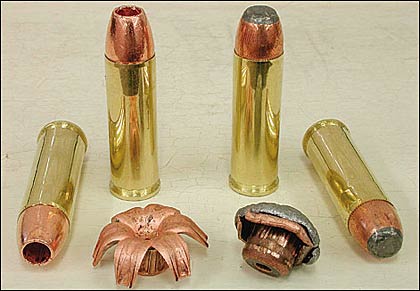 The 275-grain Barnes solid copper HEX-Bullet hollowpoint (L) and the 400-grain Hawk jacketed softpoint showed profound expansion in ballistic gelatin. |
For the next 10 months Cor-Bon marched in lockstep with the S&W "X-Gun" engineering team--Rich Mikuta, Tom Oakley, and project director Brett Curry--who took the design directly from intellectual concept to CAD solid-modeling using advanced SolidWorks computer software and then to seamless programming into the S&W's computerized CNC-manufacturing machinery without touching pen to paper or constructing any model prototypes. The very first actual parts fabricated and assembled into a whole gun were essentially the final finished design. The direct creation of an entirely new-concept, high-performance product with such speed is possible only via advanced computerized engineering/manufacturing integration that would have been physically impossible in any industry just a handful of years ago.
The full details of the joint developmental story of the .500 S&W Magnum cartridge and the Model 500 revolver will doubtless be the subject of many articles and thorough shooting reviews and performance analyses yet to come in many publications, including this one. Here in this first look, we can merely skim the cream of the essential specifications and features that separate these remarkable new products from everything else that came before them.
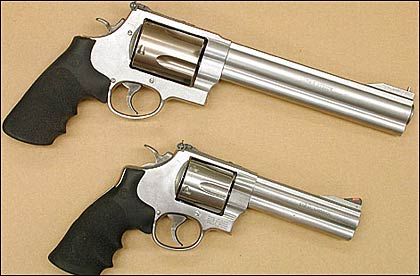 The X-Frame Model 500 Magnum Masterpiece (T) makes a large-frame Model 629 .44 Magnum look petite in comparison. |
A TOTALLY NEW CARTRIDGE
The cartridge came first, and the developers started with a completely blank screen. The caliber was the first consideration.
"It could have been a .75," Belin says, "and might have been except for the federal half-inch boundary." (He's referring to a federal regulation that requires an elaborate set of justification hurdles for any manufacturer to get approval to produce new commercial ammunition larger than .50 caliber.) "But the .50 is big enough to accomplish our goals, and if we'd gone bigger we might have just succeeded in creating an odd curiosity instead of a useful cartridge."
Cartridge length was the next consideration. That involved three concerns: to provide sufficient case capacity for a power/energy level head-and-shoulders greater than anything else existing, to make it long enough that no foolish experimenter could take any existing revolver of weaker construction and rechamber it to fire the new cartridge, and to ensure that if any other double-action revolver maker did decide it wanted to market a gun chambered for the new .500 S&W Magnum cartridge, it would also have to develop and manufacture its own entirely new frame size as well. (Business is
business, after all.)
The resultant .500 S&W Magnum cartridge carries .50-caliber bullets with a 1.625-inch maximum case length (a .44 Magnum case is 1.285 inches) and 0.065-inch rim thickness. It will be initially available from Cor-Bon in three factory loadings: a 275-grain Barnes solid-copper HEX-Bullet hollowpoint with 1662 fps muzzle velocity and 1685 ft-lbs muzzle energy at a maximum average pressure (MAP) of 26,800 psi, a 400-grain Hawk Precision Jacketed Flat Point with 1676 fps velocity and 2492 ft-lbs energy at 46,500 psi MAP, and a 440-grain Cast Performance flatnose lead with 1625 fps velocity and 2578 ft-lbs energy at 49,500 psi MAP. These are Cor-Bon's initial nominal factory ratings using industry-standard 8 3/8-inch pressure barrels.
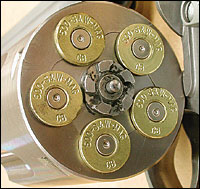 The Model 500's cylinder holds five rounds and is not counterbored, which shows the designers' confidence in the strength of the case design and the cylinder. |
It is particularly significant that even though the .500 S&W Magnum cartridge tops out at more than a ton and a quarter of muzzle energy, all the loads operate under 50,000 psi, which, incidentally, is significantly less than the 60,000 psi SAAMI-limit MAP for the smaller caliber .454 Casull. Some other energy comparisons are also helpful: The hottest current commercial 240-grain .44 Magnum factory load offers right at 1600 ft-lbs (Winchester's specifications from a 20-inch barrel); Hornady's .480 Ruger factory load yields 1315 ft-lbs; the .475 Linebaugh launches at about 1500 ft-lbs; the most powerful commercial .454 Casull load reaches 1925 ft-lbs. For all intents and purposes, that gives the new .500 S&W Magnum a top energy 34 percent greater than the next most powerful handgun cartridge in existence. In practical terms, there is no living target walking the earth that this load does not have the potential to bring down.
AN ALL-NEW GUN
In overall general appearance, the Model 500 revolver is distinctly and diagnostically a Smith & Wesson. It has the same general overall configuration, same side-swing cylinder design, and same conventional double-action operation. It's all stainless steel with a natural satin finish, adjustable sights, and Hogue-made rubber grips just like nearly all other current premium-grade S&W revolver models. What it mostly is, however, is big. It dwarfs an S&W N-Frame Model 629 .44 Magnum. The introductory 8 3/8-inch-barreled Model 500 weighs in at a nominal 72.5 ounces--well over a pound heavier than a same-length Model 629. And beyond these externals the Model 500 also carries a variety of new design elements--the cylinder, yoke-frame interface, frame and grips, and barrel design--that set it distinctly apart from any previous S&W revolver and herald several new directions for future S&W products.
The Model 500 cylinder was the first part of the gun actually fabricated and proofed. The cylinder is a revolver's firing chamber, and unless it can handle the load, you don't have a gun. The Model 500's five-shot cylinder is 1.875 inches in diameter and 2.250 inches long--more than twice the mass of any S&W N-Frame cylinder. Its length is specced to accommodate cartridges as long as a full-length .223 Remington (let your imagination run). The five-shot design allows the bolt notch cuts to be offset and helps keep the overall size of the gun to a reasonable dimension. The chambers are not counterbored so the case heads are not enclosed--which is testimony to the designers' confidence in the strength of the case design and the cylinder itself given the power of the .500 cartridge. The cylinder is in fact proofed to 71,000 psi. While testing cylinder metallurgy in development, the S&W engineers actually tried deliberately to blow one up (wondering whether the alloy would shatter or would split) using special 90,000-psi loads. The chambers bulged slightly but did not give.
Unlike any other S&W revolver, the cylinder yoke-to-frame lockup does not utilize a center-pin running through a hollow ejector rod, nor is there any barrel-lug latch. The solid, small-diameter ejector rod is unsupported at the front, but the frame latches the yoke directly with a spring-loaded ball detent. Ball-detent yoke latch designs are sometimes criticized on the grounds that any spring-loaded device will be subject to disengagement under recoil. However, the fore/aft frame alignment of the Model 500 installation actually works with recoil, pressing the latch more firmly into its notch, rather than opening it. Plus the Model 500's direction of rifling twist causes the frame to torque more firmly against the yoke, rather than away from it, so the total effect of the 500's design is to actually strengthen the yoke-frame interface when firing, rather than stress it.
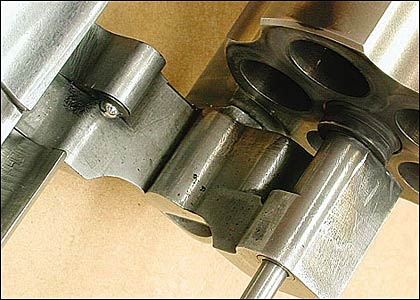 The solid, small diameter ejector rod is unsupported at the front, but the frame latches the yoke directly with a spring-loaded ball detent. |
The Model 500's frame--now officially designated as the X-Frame in the S&W lexicon--is substantially larger, thicker, and heavier than any other S&W frame in all dimensions save one. The grip frame portion is the same specification as a K/L-Frame round-butt frame. It looks weird and mismatched with the grips off--and a set of old-style K-Frame wooden round-butt service grip panels will actually fit it perfectly--but there's a compelling reason for the design. The grip designed by Hogue for the Model 500 is a full-wraparound type with recoil-cushioning internal Absorbathane inserts within the upper web portion. All other Hogue Monogrips for S&W medium- and large-frame revolvers have an open backstrap so the use of the small round-butt grip-frame dimension here on the X-Frame permits a thicker, closed-back cushioning design without increasing the overall diameter or reach of the grip beyond what feels comfortable in the grasp of an average-size hand.
At the frame's opposite end, the Model 500 also employs a new method of barrel attachment. On all other steel-frame/steel-barrel S&W revolvers, the barrel is threaded directly into the frame with a "crush-fit" interface that is forcefully tightened into proper index and requires substantial minimum barrel diameter and frame enclosure material. By contrast, the X-Frame design uses a two-part barrel assembly consisting of in internal rifled barrel tube, and a separate enclosing barrel shroud. In assembly, the shroud is first placed over the index tabs on the front of the frame, and then the barrel tube is inserted and threaded into the frame with an enlarged ring around its muzzle bringing the shroud tightly against the frame as it torques down.
The system is superficially similar to the well-known interchangeable-barrel Dan Wesson system, but unlike a Dan Wesson barrel it is a permanent installation with a hard-fitted, nonadjustable barrel-cylinder gap. Like the Dan Wesson system, however, the result is that the actual barrel with the rifled bore is supported at both ends, not just at the rear, which enhances accuracy. And, most important of all, the barrel portion that is threaded through the frame at the critical lo
cation of the forcing cone, which must absorb all the punishing impact of the bullet as it leaps from the face of the cylinder, is a nonstressed interface. This is a real benefit to the gun's longevity, considering the intensely high impact energy of the .500 Smith & Wesson Magnum cartridge.
 The grip designed by Hogue for the Model 500 (B) is a full wraparound type with recoil-cushioning Absorbathane internal cushions to moderate recoil impact. |
The barrel shroud is configured with a full-length underlug and features a removable three-vent muzzle brake that fits over the protruding rim of the internal barrel tube and held in place by a large hex-head Nylock bolt that threads into the front of the underlug. The shroud also houses an interchangeable front sight blade, which employs the spring-loaded plunger attachment mechanism originally developed for the premium-package Model 629 DX .44 Magnum series. The rear sight is the S&W standard fully adjustable Micrometer-click model. Other Model 500 features are S&W-standard, including the recently developed, key-operated revolver hammer safety lock.
Two final noteworthy items about the Model 500 separate it from current S&W revolvers in other frame sizes. One is the reincorporation for added stability of a fourth (top position) sideplate screw that was dropped from previous S&W guns in the late 1950s. The other is that the Model 500's target-configuration hammer and trigger are metal injection molded parts, which, considering the high energy and recoil velocity of the new .500 S&W Magnum cartridge, is a telling testimony to Smith & Wesson's confidence in the strength and durability of that particular form of high-tech metal fabrication technology.
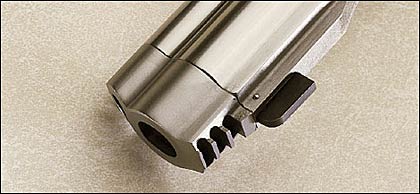 The three-vent muzzle brake fits over the protruding rim of the internal barrel tube. The interchangeable front sight blade uses a spring-loaded plunger attachment mechanism. |
Okay, those are the basics of Smith & Wesson's big, new gun and cartridge combo. The question everybody will by now be asking is "What does it feel like to shoot it?"
POWERFUL BUT SHOOTABLE
I spent a morning with Belin firing the Model 500 on the S&W Academy's indoor range. I was visiting the S&W factory in Springfield, Massachusetts, during the time the engineering department was confirming the final-stage prototype with Cor-Bon's initial .500 S&W Magnum ammunition runs.
There is absolutely no question that the gun is a profoundly powerful handful to shoot, but I should also emphasize that I had greatly over-anticipated the experience. I had seen an initial full-size Model 500 computer printout from the SolidWorks software in May of last year and had been struck by the apparent disproportion between the scale of the small, K-dimension grip-frame against the huge frame body and barrel. And I was also keenly aware of the massive power specifications for the developing .500 S&W Magnum cartridge in comparison to existing high-end handgun loads.
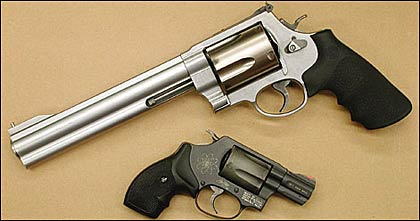 ccording to the author, S&W's Model 500 is the biggest and heaviest magnum revolver currently made, and its AirLite Sc Model 360 PD .357 Magnum is the smallest and lightest. |
Based on those observations and information, I frankly expected the Model 500 to be somewhat clumsy and unbalanced to grasp and shoot and had prepared myself for some extremely punishing recoil. My job requires me to shoot a lot of big-bore handguns in the most heavy-kicking chamberings currently available. I'm not particularly recoil-sensitive, but I'd be a liar if I did not admit I approached my first squeeze of the Model 500's trigger with some trepidation.
My expectations were wrong. In terms of handling, the wraparound Hogue grips are comfortably handfilling without excessive reach, the weight of the frame sits directly over the support hand in a two-hand grasp, and the full-lug barrel imparts a comfortable forward balance without excessive heaviness. As for recoil, make no mistake, the Model 500 comes right back at you when you touch it off. But it is not more difficult to handle than any other existing powerhouse handgun chambering, and it is surprisingly more comfortable and less abrupt than some other well-known and popular existing big-revolver designs.
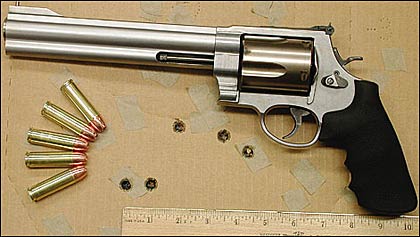 Shooting offhand at 30 yards without benefit of the muzzle brake, Dick put five shots into four inches with S&W's new .500 Magnum X-Frame revolver. |
The key to what I call the "shootability" of today's heaviest power handguns is their application of recoil management technology, primarily in the area of grip configuration and muzzle brake/compensator applications. For example, I do not consider guns like the original-design Smith & Wesson Model 29 .44 Magnum four inch, with its light-profile barrel (by today's standards) and hard-checkered wooden grips, or the relatively lightweight Ruger Super Redhawk .454 Casull with its unported barrel and noncushioned wood-insert grips to be particularly "shootable." Both are very good, very functional tools, but after about three rounds fired in succession, you want to put them down. On the other hand, you can shoot guns like the Taurus Raging Bull .454 Casull with its rubber shock-absorber grip insert and heavy-profile full-lug barrel with integral muzzle brake or a Magnum Research BFR .475 Linebaugh single-action revolver with Pachmayr grips and a good aftermarket muzzle brake all day.
Likewise, you can shoot the Model 500 all day too. The combination of the Hogue Absorbathane-insert cushion grip design and the muzzle brake work well to temper the gun's muzzle flip and moderate its impact back into the hand. Of course, each of the three available bullet weights and energy levels of Cor-Bon's initial .500 S&W Magnum loadings has its own individual recoil profile, and the differences are distinct. I did not have any other big-bore guns to actually shoot side by side with the Model 500, but here are my comparative impressions of how it felt. With a prototype muzzle brake in place, firing the 275-grain Barnes Hex-bullet .500 S&W load seemed to me subjectively to be very similar to firing a factory-issue Ruger Super Redhawk chambered for .480 Ruger or an MRI BFR .475 Linebaugh with muzzle brake--both of which I consider to be very shootable, comfortable-to-handle combinations. Firing the 400-grain Hawk Precision JFP or the 440-grain Cast Performance flatnose load is notably more abrupt and similar to th
e feel of a full-power 300-grain .454 Casull load in a Taurus Raging Bull. Shooting the same loads without the muzzle brake was a different story; the flip was excessive. Very few handgunners will ever want to shoot the Model 500 without its muzzle brake attached.
Admittedly, shootability is a subjective concept. Depending on personal differences in handling technique and recoil sensitivity, what's shootable for one will not necessarily be shootable for another. But this is how the Model 500 feels in my hand, at least, compared to some of the other heavy-hitters with which you might be familiar that are already out there. And one thing I'm absolutely certain of is the Model 500 is much, much more comfortable to shoot than the revolver you might consider its extreme opposite--the little 10-ounce, J-Frame S&W Model 360 AirLite Sc .357 Magnum.
| SPECS | 

Manufacturer: Smith & Wesson
Model: 500
Operation: Double-action revolver
Caliber: .500 S&W Magnum
Barrel length: 8.38 inches
Overall length: 15.0 inches
Weight, empty: 72.5 ounces
Safety: Internal self-engaging hammerblock; safety hammer keylock
Sights: Adjustable rear; interchangeable post front
Sight radius: 10.75 inches
Rifling: 6 grooves, 1:18.75 LH twist
Stocks: Hogue rubber Monogrips
Cylinder capacity: 5 rounds
Finish: Brushed stainless steel
|
|
As for accuracy, the circumstances of my day at Smith & Wesson with the Model 500 did not allow a formal shooting review, but I had no problem printing four-inch groups with the 275-grain load firing the gun standing at plain-surface (no aiming point) 30-yard IDPA targets. I have absolutely no doubt that when I sit down at the benchrest with the Model 500 equipped with a good optical sight, I'll be able to cut that by more than half. Besides, I'm certainly not ashamed of four inches offhand at 30 yards distance with a big boomer like this, shooting in the "concussion-chamber" of an enclosed indoor range without the muzzle brake. (The nonlocked screw holding the prototype muzzle brake on the preproduction gun came loose while I was shooting and dropped it slightly in front of the muzzle; the next shot destroyed it.)
The new Model 500 in .500 S&W Magnum is an impressive, indeed historic, shooting tool, and the introduction of the X-Frame design also provides Smith & Wesson with substantial additional opportunity for developments beyond its initial configuration and chambering. S&W planners are already discussing the possibility of additional new, super-long, super-powerful .475-caliber and .450-caliber "S&W Magnum" cartridges for the gun. Plus the dimensions and pressure capabilities of the X-Frame cylinder also offer the potential to chamber various full-length bottleneck rifle cartridges--like the .223 Remington or even (perhaps?) the new .223 Winchester Super Short Magnum. How about a four-inch .500 S&W "Bear-Defense" version for Alaskan fishermen? Or an X-Frame eight-shot .44 Magnum version built with a scandium/aluminum-alloy frame that would weigh less than a current N-Frame Model 629?
There are few big-bore revolver enthusiasts in the world who do not carry a clear picture in their memory of the cinematic moment in 1972 when Clint Eastwood aimed a Smith & Wesson Model 29 between the eyes of a recalcitrant felon and snarled, "This here being a .44 Magnum, the most powerful handgun in the world, you gotta ask yourself. . .do you feel lucky?"
It's time for Clint to make another movie.

